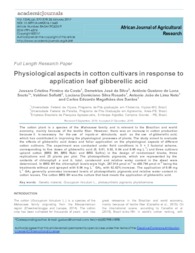Physiological aspects in cotton cultivars in response to application leaf gibberellic acid.
Physiological aspects in cotton cultivars in response to application leaf gibberellic acid.
Author(s): COSTA, J. C. F. da; SILVA, D. J. da; SOUTO, A. G. de L.; SOFIATTI, V.; ROSADO, L. D. S.; LIMA NETO, A. J. de; SANTOS, C. E. M. dos
Summary: The cotton plant is a species of the Malvaceae family and is relevant to the Brazilian and world economy, mainly because of the textile fiber. However, there was an increase in cotton production because it is necessary for the use of inputs or stimulants, such as the use of gibberellic acid, which has contributed in improving the physiological processes of plants. The study aimed to evaluate the effects of gibberellic acid doses and foliar application on the physiological aspects of different cotton cultivars. The experiment was conducted under field conditions in 5 × 3 factorial scheme, corresponding to five doses of gibberellic acid (0, 0.01, 0.02, 0.04 and 0.06 mg L-1) and three cultivars upland cotton (BRS 8H, BRS Rubi and BRS Safira) in the design of randomized blocks, three replications and 25 plants per plot. The photosynthetic pigments, which are represented by the contents of chlorophyll a and b, total, carotenoid and relative water content in the sheet were determined. In BRS 8H the chlorophyll levels were high, 287.914 ?mol m-2 to 468.796 ?mol m-2 being the treatments without and sprayed with 0.06 mg L-1 GA3, with 62.82% increase. The application of 0.06 mg L-1 GA3 generally promotes increased levels of photosynthetic pigments and relative water content in cotton leaves. The cotton BRS 8H was the culture that best meets the application of gibberellic acid.
Publication year: 2017
Types of publication: Journal article
Unit: Embrapa Cotton
Observation
Some of Embrapa's publications are published as ePub files. To read them, use or download one of the following free software options to your computer or mobile device. Android: Google Play Books; IOS: iBooks; Windows and Linux: Calibre.
Access other publications
Access the Agricultural Research Database (BDPA) to consult Embrapa's full library collection and records.
Visit Embrapa Bookstore to purchase books and other publications sold by Embrapa.

